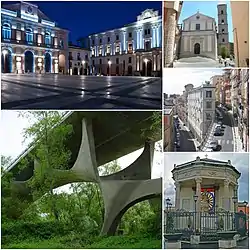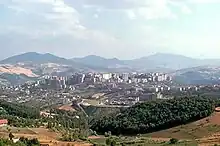Potenza
Potenza (/pəˈtɛnzə/, also US: /poʊˈtɛntsɑː/,[3][4] Italian: [poˈtɛntsa] ⓘ; Neapolitan: Putenza, Potentino dialect: Putenz) is a comune in the Southern Italian region of Basilicata (former Lucania).
Potenza
| |
|---|---|
| Città di Potenza | |
 Left: A view of Mario Pagano Square, Stabile Theater, Potenza Province Office, Musmeci Bridge, Right: Potenza San Gerardo Cathedral, Reale Palace, San Gerardo Temple (from top to bottom) | |
 Flag  Coat of arms | |
.svg.png.webp) Potenza within the Province of Potenza | |
Location of Potenza | |
 Potenza Location of Potenza in Basilicata  Potenza Potenza (Basilicata) | |
| Coordinates: 40°38′N 15°48′E | |
| Country | Italy |
| Region | Basilicata |
| Province | Potenza (PZ) |
| Government | |
| • Mayor | Mario Guarente (Lega) |
| Area | |
| • Total | 173 km2 (67 sq mi) |
| Elevation | 819 m (2,687 ft) |
| Population (31 May 2015)[2] | |
| • Total | 67,348 |
| • Density | 390/km2 (1,000/sq mi) |
| Demonym | Potentini |
| Time zone | UTC+1 (CET) |
| • Summer (DST) | UTC+2 (CEST) |
| Postal code | 85100 |
| Dialing code | 0971 |
| Patron saint | St. Gerard |
| Saint day | May 30 |
| Website | Official website |
Capital of the Province of Potenza and the Basilicata region, the city is the highest regional capital and one of the highest provincial capitals in Italy, overlooking the valley of the Basento river in the Apennine Mountains of Lucania, east of Salerno. Its territory is bounded by the comuni of Anzi, Avigliano, Brindisi Montagna, Picerno, Pietragalla, Pignola, Ruoti, Tito and Vaglio Basilicata.
History of Potenza
Ancient times
The first settlement of Potentia (Potenza's original Latin name) was probably located at a lower elevation than at present, some 10 kilometres (6 miles) south of today's Potenza. The Lucanians of Potentia sided against Rome's enemies during the latter's wars against the Samnites and the Bruttii. Subjugated during the 4th century BC (later gaining the status of municipium), the Potentini rebelled after the Roman defeat at Cannae in 216 BC.
However, the Battle of the Metaurus marked the end of any Carthaginian aspirations in Italy and Potentia was reconquered by the Romans and reduced to the status of military colony.
Middle Ages
In the 6th century, the city passed to the Lombard Duchy of Benevento. Incursions by Saracen raiders menaced the city until the Norman conquest of southern Italy secured the area. In the 12th century, Potenza became an episcopal see. In 1137, the city hosted Pope Innocent II and Emperor Lothair II during their failed attempt to conquer the Norman kingdom. In 1148 or 1149 in Potenza, Roger II of Sicily hosted King Louis VII of France, whom the Norman fleet had freed from the Saracens. After pillaging by Emperor Frederick II, the city remained loyal to the Hohenstaufen: as a result, it was almost totally destroyed by Charles I when the Angevin lord conquered the Kingdom of Sicily. On 18 December 1273, an earthquake further devastated the city.

Modern age
In the following years of the Late Middle Ages, the city was owned by various feudal families before the Spanish domination, during which Potenza was the site of riots against the Spaniards. In 1694, it was almost completely destroyed by another earthquake.
With the declaration of the Neapolitan Republic in 1799, Potenza was one of the first cities to rebel against the king. After temporary Bourbon repression, the city was conquered by the French army in 1806 and declared the capital of Basilicata. King Joachim Murat improved the city's living conditions and administration, while some urban improvements were also introduced for the visit of Ferdinand II in 1846.
A revolt broke out in 1848 and was again put down by Bourbon forces, until a third devastating earthquake followed in 1857. Potenza rebelled for the last time in 1860, before Garibaldi's revolutionary army brought about the unification of Italy.
In September 1943, the city suffered heavy Allied bombing. In 1980, another strong earthquake struck Potenza.
Main sights

- Potenza Cathedral: The Duomo di San Gerardo, renovated in the 18th century. The cathedral still houses the rose window and the apse from the original 12th-century structure.
- San Francesco: church founded in 1274. The portal and the bell tower date from the 15th century. The church houses the De Grasis sepulchre and a Madonna in Byzantine style (13th century).
- The Torre Guevara, the last remnant of the old castle. It is now used to stage art exhibitions.
- The Palazzo Loffredo, a 17th-century noble residence. It now houses the National Archaeological Museum of Basilicata, dedicated to archaeologist Dinu Adameșteanu.[5]
- Three gates of the old city walls, now demolished. The gates are the Porta San Giovanni, the Porta San Luca and the Porta San Gerardo.
- San Michele: 11th-12th century Romanesque-style church.
- Santa Maria del Sepolcro: church.
- The ruins of a Roman villa in the Poggio Tre Galli quarter.
- Musmeci Bridge, a unique construction, monument of modern civil engineering.
Geography
Climate
Potenza experiences an oceanic climate (Cfb in the Köppen climate classification), failing narrowly to classify as warm-summer Mediterranean climate (Csb) because the month with the most precipitation has slightly less than three times as much as the driest month.
| Climate data for Potenza | |||||||||||||
|---|---|---|---|---|---|---|---|---|---|---|---|---|---|
| Month | Jan | Feb | Mar | Apr | May | Jun | Jul | Aug | Sep | Oct | Nov | Dec | Year |
| Record high °C (°F) | 20.0 (68.0) |
21.8 (71.2) |
23.6 (74.5) |
25.6 (78.1) |
29.8 (85.6) |
33.0 (91.4) |
36.8 (98.2) |
36.8 (98.2) |
33.2 (91.8) |
30.0 (86.0) |
21.8 (71.2) |
20.0 (68.0) |
36.8 (98.2) |
| Average high °C (°F) | 6.9 (44.4) |
7.2 (45.0) |
9.7 (49.5) |
12.8 (55.0) |
18.1 (64.6) |
22.3 (72.1) |
25.7 (78.3) |
25.8 (78.4) |
21.7 (71.1) |
16.5 (61.7) |
11.0 (51.8) |
7.9 (46.2) |
15.5 (59.8) |
| Daily mean °C (°F) | 4.0 (39.2) |
4.1 (39.4) |
6.1 (43.0) |
8.8 (47.8) |
13.7 (56.7) |
17.5 (63.5) |
20.6 (69.1) |
20.7 (69.3) |
17.2 (63.0) |
12.7 (54.9) |
7.9 (46.2) |
5.1 (41.2) |
11.5 (52.8) |
| Average low °C (°F) | 1.2 (34.2) |
1.1 (34.0) |
2.5 (36.5) |
4.8 (40.6) |
9.2 (48.6) |
12.7 (54.9) |
15.4 (59.7) |
15.7 (60.3) |
12.7 (54.9) |
8.9 (48.0) |
4.7 (40.5) |
2.3 (36.1) |
7.6 (45.7) |
| Record low °C (°F) | −9.6 (14.7) |
−10 (14) |
−7.8 (18.0) |
−3.6 (25.5) |
0.5 (32.9) |
4.0 (39.2) |
8.0 (46.4) |
6.8 (44.2) |
1.2 (34.2) |
−1.2 (29.8) |
−7 (19) |
−8 (18) |
−10 (14) |
| Average precipitation mm (inches) | 55.7 (2.19) |
63.0 (2.48) |
48.6 (1.91) |
66.8 (2.63) |
42.8 (1.69) |
30.4 (1.20) |
26.1 (1.03) |
32.6 (1.28) |
46.2 (1.82) |
61.6 (2.43) |
73.3 (2.89) |
66.0 (2.60) |
613.1 (24.15) |
| Average precipitation days (≥ 1 mm) | 8.3 | 8.7 | 8.8 | 9.4 | 6.2 | 4.2 | 3.3 | 4.3 | 5.3 | 7.5 | 8.7 | 8.1 | 82.8 |
| Average relative humidity (%) | 77 | 75 | 72 | 69 | 69 | 67 | 62 | 64 | 66 | 72 | 76 | 78 | 71 |
| Source 1: Servizio Meteorologico (1971–2000 data)[6] | |||||||||||||
| Source 2: Servizio Meteorologico (1961–1990 data on average humidity)[7] | |||||||||||||

Population
Potenza has a population of 67,122 as of 2015. It is the largest city in Basilicata.
| Date | Census data |
|---|---|
| 1991 | 65,714 |
| 2001 | 69,060 |
| 2011 | 66,777 |
| 2015 | 67,122 |
Source: [8]

Transportation
Road
Potenza is located at the eastern end of the RA5 motorway, a 50 km (31 mi) branch from the A2 motorway.
Rail
Potenza is a rail junction on the main line from Salerno to Taranto, managed by FS Trenitalia. It has also a connection to Altamura and its own small metropolitan railway service, served by the Ferrovie Appulo Lucane regional company. The city's main station, which was originally named Potenza Inferiore, is now known as Potenza Centrale.
The nearest airports are:
- Salerno-Pontecagnano QSR 85 km (53 mi)
- Foggia-Gino Lisa FOG 101 km (63 mi)
- Bari-Palese BRI 130 km (81 mi)
Escalators
With the city centre situated at the top of a steep hill, escalators provide a form of public transport in Potenza. The largest, Santa Lucia Escalator (Italian: Scale Mobili Santa Lucia), is approximately 500 m (1,600 ft) long and connects Potenza's historic centre with a residential neighbourhood to the west by descending 100 m (330 ft) into a valley. Potenza's public escalator network is the largest in Europe and the second largest in the world after Tokyo.[9]
People
- Saint Gerard of Potenza (died 1118) – bishop
- Giovanni Andrea Serrao (1731-1799) – intellectual and churchman
- Ascanio Branca (1840-1903) - politician [10]
- Domenico Montesano (1863-1930) - mathematician
- Tanio Boccia (1912–1982) – film director
- Emilio Colombo (11 April 1920 – 24 June 2013) – politician
- Salvatore Dierna (1934-2016), architect
- Ruggero Deodato (1939–2022) – film director
- Wally Buono (1950) – (CFL) football head coach (Calgary Stampeders, BC Lions)
- Luciana Lamorgese (1953) – politician
- Cecilia D'Elia (1963) – politician
- Donato Sabia (1963-2020) – former middle distance runner
- Francesco Colonnese (1971) – former football player
- Giovanni Frezza (1972) – film actor
- Danilo Restivo (1972) – double murderer
- Vito Postiglione (1977) – racing driver
- Roberto Speranza (1979) – politician
- William Cutolo (1949 - 1999), also known as "Billy Fingers" and "Wild Bill", powerful labor racketeer and underboss for the Colombo Crime Family
International relations
Potenza is twinned with:
References
- "Superficie di Comuni Province e Regioni italiane al 9 ottobre 2011". Italian National Institute of Statistics. Retrieved 16 March 2019.
- "Popolazione Residente al 1° Gennaio 2018". Italian National Institute of Statistics. Retrieved 16 March 2019.
- "Potenza". The American Heritage Dictionary of the English Language (5th ed.). HarperCollins. Retrieved 1 May 2019.
- "Potenza". Oxford Dictionaries UK English Dictionary. Oxford University Press.
- "Potenza:Archaeological Museums". Basilicata Turistica. Retrieved 26 September 2021.
- "Potenza (PZ) 845 m. s.l.m. (a.s.l.)" (PDF) (in Italian and English). Servizio Meteorologico. Archived from the original (PDF) on 9 April 2015. Retrieved 10 September 2013.
- "Stazione 300 Potenza, medie mensili periodo 61 - 90". Servizio Meteorologico. Archived from the original on 10 January 2010. Retrieved 10 September 2013.
- "Potenza (Potenza, Basilicata, Italy)". City Population. Retrieved 31 March 2017.
- "Potenza Capoluogo è la città con le scale mobili più lunghe d'Europa". Le Cronache (in Italian). 4 June 2017. Retrieved 28 December 2020.
- "Treccani - la cultura italiana | Treccani, il portale del sapere".
External links
- Official website (in Italian)
- Battle of Potenza at canadiansoldiers.com
- Music State Conservatory "Carlo Gesualdo da Venosa"